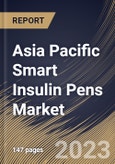One of the pivotal factors driving the innovation and development of these pens is the growing awareness of the importance of diabetes management and the desire to improve the quality of life for those affected by the condition. Diabetes has far-reaching health and economic implications, and its management requires continuous attention and strict adherence to insulin regimens. The introduction of these pens aims to alleviate the burden on patients and healthcare providers alike, offering a user-friendly, technology-driven approach to insulin delivery and monitoring.
The expanding diabetes patient population and increased awareness, regulatory agencies and healthcare organizations have played a vital role in promoting innovation in the market. As the significance of these devices in diabetes management has become more widely recognized, regulatory approvals and standards have been established to ensure the safety and efficacy of the pens. These regulatory frameworks provide assurance to patients, healthcare providers, and manufacturers, promoting investment in research and development.
According to the 2020 data from the Organisation for Economic Co-operation and Development (OECD), about 227 million people in the Asia Pacific live with type 2 diabetes. The prevalence of diabetes among adults in the Asia Pacific nations ranged from 5% in Australia to 18.9% in Fiji for women and from 5.5% in Vietnam to 15.9% in Fiji for men. Moreover, with over 141 million people with diabetes, China accounts for one in four people with the condition worldwide, as reported by the International Diabetes Federation. Therefore, the region will present lucrative growth prospects for the market in the coming years.
The China market dominated the Asia Pacific Smart Insulin Pens Market, By Country in 2022, and would continue to be a dominant market till 2030; thereby, achieving a market value of $15,132.5 Thousands by 2030. The Japan market is registering a CAGR of 10.5% during (2023 - 2030). Additionally, The India market would showcase a CAGR of 12% during (2023 - 2030).
Based on Usability, the market is segmented into Prefilled, and Reusable. Based on Product, the market is segmented into First Generation Pens, and Second Generation Pens (USB Connected, Bluetooth-Enabled). Based on End User, the market is segmented into Hospitals & Clinics, Ambulatory Surgical Centers, and Home Care Settings. Based on countries, the market is segmented into China, Japan, India, South Korea, Singapore, Malaysia, and Rest of Asia Pacific.
The market research report covers the analysis of key stake holders of the market. Key companies profiled in the report include Medtronic PLC, Eli Lilly And Company, Novo Nordisk A/S, F. Hoffmann-La Roche Ltd, Emperra GmbH, Jiangsu Delfu Medical Device Co.,Ltd, Abbott Laboratories and Ypsomed AG.
Scope of the Study
Market Segments Covered in the Report:
By Usability (Volume, Thousand Units, Revenue, USD Million, 2019-30)- Prefilled
- Reusable
- First Generation Pens
- Second Generation Pens
- USB Connected
- Bluetooth-Enabled
- Hospitals & Clinics
- Ambulatory Surgical Centers
- Home Care Settings
- China
- Japan
- India
- South Korea
- Singapore
- Malaysia
- Rest of Asia Pacific
Key Market Players
List of Companies Profiled in the Report:
- Medtronic PLC
- Eli Lilly And Company
- Novo Nordisk A/S
- F.Hoffmann-La Roche Ltd
- Emperra GmbH
- Jiangsu Delfu Medical Device Co.,Ltd
- Abbott Laboratories
- Ypsomed AG
Unique Offerings
- Exhaustive coverage
- The highest number of Market tables and figures
- Subscription-based model available
- Guaranteed best price
- Assured post sales research support with 10% customization free
Table of Contents
Companies Mentioned
- Medtronic PLC
- Eli Lilly And Company
- Novo Nordisk A/S
- F. Hoffmann-La Roche Ltd
- Emperra GmbH
- Jiangsu Delfu Medical Device Co.,Ltd
- Abbott Laboratories
- Ypsomed AG
Methodology

LOADING...








